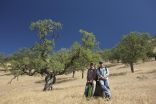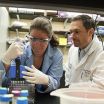Even the perceived risk of disease prompts intention to act
2014-12-05
(Press-News.org) With so much focus on risk factors for disease, we are living in an era of surveillance medicine, in which the emphasis on risk blurs the lines between health and illness, argue researchers at Yale and Syracuse universities in a study published in the December issue of the Journal of Health and Social Behavior.
Co-authors Rene Almeling, assistant professor of sociology at Yale, and Shana Kushner Gadarian, assistant professor of political science at Syracuse University, conducted a nationwide survey of American adults to determine if healthy people react to hypothetical genetic risk information by wanting to take action.
Participants were asked to imagine that they faced a genetic risk for a disease. They were randomly assigned a level of risk (between 20% and 80%) and a disease: heart disease, colon cancer, or Alzheimer's disease. These are all common conditions that affect roughly equal numbers of women and men and are caused by a mix of genetic and environmental factors, but differ in age of onset and treatability.
The survey allowed the researchers to recreate the uncertainty and concern posed by potential illness, and then systematically assess who wanted to take which kinds of actions in response to different levels and kinds of risks.
The main finding of the study was that as the level of risk increases from 20% to 80%, people are more likely to want to take action of all kinds, including seeking information about the disease, managing risk by taking medications or undergoing surgery, consulting family members, organizing finances, and participating in community and political events.
The results of the survey showed the importance of risk information even to healthy people, suggesting that the experience of living between health and disease is not just limited to those who are already patients. "Social scientists have argued that we are now treating risk as if it were a disease, and these results provide strong evidence for that claim," says Almeling.
Participants were asked if they have a family member or close friend with the disease to which they had been assigned to assess whether experience with the disease increased their interest in taking action. The researchers were startled to find that seeing a disease up close did not make much difference; across the board, people responded to the hypothetical risk information by wanting to take action.
The survey questions were hypothetical, but the issues that the study raises are real, note the researchers, adding that people use risk information to make significant medical decisions, such as whether to increase the frequency of cancer screenings or undergo prophylactic surgery.
"It is extremely important for social scientists and clinicians to understand how people respond to these risk numbers and how they are being used to make important life decisions," says Almeling. She added, "Studies like this can aid health care providers in offering genetic information with sufficient context to insure that people make the best decisions for themselves."
Given that people throughout the population -- from the healthy to the sick and those with and without a family history of disease -- had largely identical reactions suggests that normality has indeed become precarious and that we are all patients-in-waiting, say the researchers.
INFORMATION:
ELSE PRESS RELEASES FROM THIS DATE:
2014-12-05
The Ku Klux Klan's failure to defeat the black civil rights moment is well documented, but the group's lesser-known legacy may be its lasting impact on the U.S. political system, according to a paper published in the December issue of the American Sociological Review.
David Cunningham, professor and chair of the Department of Sociology at Brandeis University, Rory McVeigh of the University of Notre Dame and Justin Farrell of Yale University report that KKK activity played a significant role in shifting voters' political party allegiance in the South in the 1960s -- from ...
2014-12-05
(NEW YORK - December 5, 2014) A key protein may represent a new way to use the immune system to speed healing and counter inflammatory, infectious and autoimmune diseases, according to study led by researchers at the Icahn School of Medicine at Mount Sinai and published in the December issue of Cell Reports.
The current study results revolve around proteinases, enzymes that break down proteins as part of cellular life. Matrix metalloproteinases or MMPs specifically target the extracellular matrix, the non-cell, structural framework within tissues. Beyond that role, ...
2014-12-05
CHICAGO (December 5, 2014): Malnutrition is an important factor predicting long-term survival in older patients undergoing pancreaticoduodenectomy (PD) (commonly called the Whipple procedure) to treat benign tumors and cysts of the pancreas as well as pancreatitis, according to new study results published in the December issue of the Journal of the American College of Surgeons.
"A comprehensive geriatric assessment of elderly patients who are being evaluated for the Whipple procedure is essential," said lead study author Dominic Sanford, MD, MPHS, a general surgery ...
2014-12-05
Super Typhoon Hagupit is forecast to make landfall in the eastern Philippines bringing heavy rainfall, damaging winds and storm surge. NASA/JAXA's TRMM satellite and the RapidScat instrument provided rainfall and wind data, while NASA-NOAA's Suomi NPP satellite provided a visible image of the storm. In the Philippines, Hagupit is known locally as "Typhoon Ruby."
The Tropical Rainfall Measuring Mission or TRMM satellite caught a good view of Super Typhoon Hagupit on December 4, 2014 at 1721 UTC (12:21 p.m. EST) when its sustained winds were estimated at over 145 knots ...
2014-12-05
ABBOTT PARK, Ill., Dec. 4, 2014 - Even in food-abundant industrialized countries like the U.S., an alarming number of people, particularly seniors, are in a state of diseased-associated malnutrition . Because of the impact on patient health, disease-associated malnutrition imposes a significant economic burden on society of $157 billion per year, according to new research published in a supplemental issue of the Journal of Parenteral and Enteral Nutrition (JPEN) and supported by Abbott .
Researchers looked at malnutrition across eight specific diseases* and evaluated ...
2014-12-05
(Salt Lake City) --How can people who are dependent on prescription opioids reduce their cravings? Learn to enjoy other aspects of their lives.
That's the key finding in a new study published in the Journal of Behavioral Medicine by Eric L. Garland, associate professor at the University of Utah College of Social Work. Garland and colleagues studied how an intervention program for chronic pain patients called Mindfulness-Oriented Recovery Enhancement (MORE) decreased patients' desire for prescription drugs.
The MORE intervention concentrates on helping people ...
2014-12-05
As California finally experiences the arrival of a rain-bearing Pineapple Express this week, two climate scientists from the University of Minnesota and Woods Hole Oceanographic Institution have shown that the drought of 2012-2014 has been the worst in 1,200 years.
Daniel Griffin, an assistant professor in the Department of Geography, Environment and Society at the University of Minnesota, and Kevin Anchukaitis, an assistant scientist at Woods Hole Oceanographic Institution, asked the question, "How unusual is the ongoing California drought?" Watching the severity of ...
2014-12-05
Genetic mutations may cause more cases of amyotrophic lateral sclerosis (ALS) than scientists previously had realized, according to researchers at Washington University School of Medicine in St. Louis and Cedars-Sinai Medical Center in Los Angeles. The scientists also showed that the number of mutated genes influences the age when the fatal paralyzing disorder first appears.
ALS, also known as Lou Gehrig's disease, destroys the nerve cells that control muscles, leading to loss of mobility, difficulty breathing and swallowing, and eventually paralysis and death. Understanding ...
2014-12-05
The Institute for Quality and Efficiency in Health Care (IQWiG) investigated in a dossier assessment whether propranolol offers an added benefit in comparison with the appropriate comparator therapy in infants with proliferating infantile haemangioma (sometimes called "strawberry mark").
According to the findings, there is an indication of major added benefit of propranolol in some children, i.e. those with haemangioma with a risk of permanent scars or disfigurement. In contrast, an added benefit is not proven for children with life- or function-threatening haemangioma, ...
2014-12-05
The vicious cycle of diabetes describes a scenario where people are becoming fatter, often with elevated levels of glucose, and at increased risk for women to develop gestational diabetes (GDM). Intrauterine exposure to GDM, itself, is a major risk factor for later obesity and diabetes, thus perpetuating this maternal-offspring cycle of disease.
Researchers from Lund University have published an overview of evidence across the past few decades in the journal Diabetes, Metabolic Syndrome and Obesity: Targets and Therapy. They emphasize the need to update diabetes prevention ...
LAST 30 PRESS RELEASES:
[Press-News.org] Even the perceived risk of disease prompts intention to act




